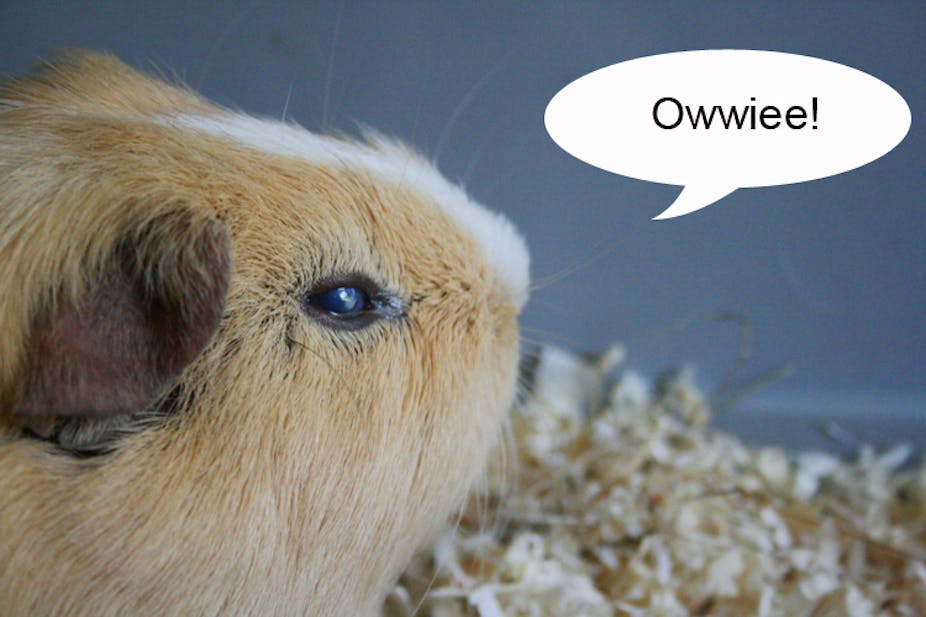It is no coincidence that we describe the “pain” of loneliness or the “agony” of rejected romantic feelings. Paper cuts can be “excruciatingly painful”, but so can watching the social mishaps of Basil Fawlty or David Brent. Personal criticism can be “stinging”.
The book The Patient’s Brain outlines the evidence that later evolutionary traits such as social cognition and language appear to have grafted themselves onto the ancient brain functions that alerted us to external threats or bodily damage.
Words are neurological events. They are meaning-laden puffs of air that our brain transforms into knowledge, opinions, emotions or danger signals.
Shakespeare, perhaps the greatest wordsmith of all time, frequently used bodily sensations including sensitivity to pain as metaphors. If you’ve ever complained about the “bitter cold”, called an ugly sight an “eyesore” or felt it “sharper than a serpent’s tooth … to have a thankless child” you might know what I mean.
Words affect pain
The “right” words in a medical context can activate both the pain-busting endogenous opioid networks in the brain and the feel-good dopamine-driven reward centres. One of the most widely relied-upon pain assessment questionnaires, the McGill Pain Questionnaire, relies entirely on verbal descriptions of pain to diagnose the severity of someone’s pain.
I have a patient with complex regional pain syndrome (a severe, uncommon type of nerve pain), who has little pain in her affected foot as long as she doesn’t think or talk about it. Mention the foot and her symptoms burst into life, causing a severe burning and prickling sensation. Even listening to me discussing it with her husband can set it off.
Given how important language can be to pain sufferers, well-trained clinicians go to some lengths to use appropriate terms. We can spot patients at higher risk of disability by carefully listening to how they tell us about their pain predicament. I forbid any of my trainees in pain medicine to use the following phrases in consultations because of their poisonous effect on patients:
That’s the worst I’ve ever seen
It looks like bone-on-bone
Your disc is collapsed/busted/blown out/ruined
You will end up in a wheelchair
Just learn to live with it.
No doubt readers could expand this ghastly collection of backhanded reassurances with some from their own experience. The reason such phrases are unhelpful is that they come to define all subsequent attempts at therapeutic interaction. If you have any doubt about the power of medical words to influence perceived pain, I can quote a recent study that provides a good example.
This study compared “real” acupuncture to “sham” acupuncture where both were delivered with either a neutral or highly positive endorsement from the practitioner. Both the groups who received acupuncture showed an equal improvement compared to a group left on the waiting list.

Those who received their acupuncture from a highly positive practitioner did better whether they got the “real” or the “sham” needle placement. Those who got a lukewarm practitioner didn’t get as much relief even when the needles were correctly placed.
This isn’t surprising, as this is just the most recent addition to a large literature confirming that positive feelings by the patient towards the context and manner in which an ineffective treatment is administered have an undeniable influence on short-term outcome. There’s a point to being positive when recommending treatments, though these initial responses don’t hold up over time in the absence of a genuinely therapeutic effect. You can’t fool all of the people all of the time.
Rephrasing pain
A critical task in pain psychology is therefore to help people learn to rephrase their inner monologue so it becomes more realistic and supportive. Being able to catch and recognise unhelpful or unrealistic impulses is not easy to do, but this skill is the basis of many successful adaptions to persistent pain. Imagine if every time you were pulled up short by your pain, you thought to yourself:
It’s ridiculous that I can’t do this, I’ve always been able to do it.
The resulting emotions caused by this language are frustration, shame and resentment. Anyone doing something ridiculous must be deserving of ridicule, which means the pain is making you into a figure worthy of contempt and embarrassment. Now imagine you caught yourself about to think that first thought but replaced it with:
It’s annoying I can’t do things like I used to. I’m working on getting better at it, but I’m not there yet.
This may be equally as factual as the first thought, but the tone is much less contemptuous and the resulting emotions are more likely to encourage resilience than sap morale. The thought may be father to the deed, but words are mother to the thought. This insight forms the basis of cognitive behavioural therapy (a form of psychotherapy that aims to change unhelpful thinking behaviours), which has been significant in helping people live with persistent pain for most of the last three decades.
Listen carefully to the language that surrounds people with pain. Listen to how you talk about them. Are you increasing their disability by using well-intentioned pain cliches?
If you have persistent pain, it can be valuable to test yourself and see if you may be holding yourself back without knowing it. A better life may be just a few helpful phrases away.
This article is part of a series focusing on Pain. Read other articles in the series here.
Michael will be on hand for an Twitter Q&A between 11am and noon AEDT on Thursday, December 3rd, 2015. Post your questions on Twitter using the hashtag #AskAnExpert.

